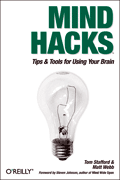OK, so I'm a geek. Let's just start there.
As a fan of Dr. Eliyahu Goldratt's Theory of Constraints (TOC) I have been surprised at how powerful its underlying concepts can be. Unlike many "process improvement" programs, Goldratt's TOC is a system improvement approach. The simple concept at its heart is that any system has only one constraint (aka "the weakest link" or "bottleneck") at any given time. 
Furthermore, his theory says that any work that doesn't maximize the effectiveness of the constraint is wasted. In other words, work that doesn't allow the constraint to perform at its optimal capacity doesn't increase the throughput of the system, so your effort would likely be better spent elsewhere.
Another key component of TOC is that it is a system view and it preaches that you should focus on the throughput of the system as a whole, not on local optima. In other words, the system should maximize the throughput of the bottleneck resource even if that means that other resources sit idle. On the surface, that may seem counter-intuitive, but that's just because our intuition has been fed by a cost-accounting philosophy rather than a throughput-accounting philosophy.
The Roots of TOC
TOC first became known as a Manufacturing Resource Planning (MRP) approach that provided immense improvements in the effectiveness of manufacturing businesses. While manufacturing is the first place TOC gained its glory, the principles of TOC can be applied to virtually any system, in any business.
Goldratt himself is a phycisist, so it's no surprise that TOC is based on a small set of very simple "rules" with very complex implications and interactions. This paradox of complex simplicity makes it simultaneously easy to understand but difficult to master the precepts of TOC.
I'm a fairly conceptual thinker, so I have found it easy to apply theories of TOC at a high level, but I've found it difficult to really master the nuances of the "Thinking Processes" of TOC and execute on the technical aspects of TOC. While the processes are used heavily in all of Goldratt's books and I've read most of them, the books are presented in the style of novels. As a result, there are not a lot of tutorial-level details to help you learn the Thinking Processes on your own. [An introduction to TOC and the thinking processes is available in a free PDF from Goldratt.com]
Resource 1: A step-by-step tutuorial on the TOC Thinking Process
At last, I have found a book (looks like a textbook, in fact), Goldratt's Theory of Constraint's by H. William Dettmer, that takes you through the end-to-end process of using the Thinking Processes to create such TOC topics as:
- Creating, debugging, and diagnosing Current Reality Trees
- Creating and using Conflict Resolution Diagrams ("evaporating clouds")
- Developing Prerequisite Trees to systematically deal with obstacles
- Building and using Transition Trees
In this book, Dettmer takes you through the mechanics (graphical conventions, step-by-step processes for using and applying the Thinking Processes), but also takes you a step further. There is considerable material on how to use these processes and diagrams to communicate with others, particularly stakeholders from which you need buy-in.
if you are new to Goldratt's Theory of Constraints, Dettmer starts the book with a very clear overview of what TOC is all about, even going so far as to cover how to apply TOC in non-profit organizations, and provide additional application notes to enable you to apply it in different environments.
Resource 2: Learning from Goldratt himself - now it's within your grasp
Last week, I took delivery of "Beyond The Goal: Eliyahu Goldratt Speaks on the Theory of Constraints" which is an 8-CD set containing the audio of a very comprehensive lecture by Dr. Goldratt. He takes us through the development of his Theory of Constraints by weaving a fascinating tapestry of stories to illustrate the concepts. Thankfully, for those of us who tend to be a bit more visual, CD number 8 also has all of the PowerPoint slides he uses during his lecture. I printed them out and it's been very helpful to have them handy as I listen to him speak.
One word of caution on this set - while TOC can ostensibly be applied to any system, the focus of this lecture is very MRP- / ERP-centric. That said, Godratt provides a lot of non-manufacturing examples, such as hospitals, fire departments, etc. and even applies TOC concepts to the Sales process.
If you are an abstract thinker, it is easy to listen to this and do the concept "mapping" in your head so you can apply this to other applications outside the MRP/ERP world. If you are a literal thinker, this one may be a frustrating listen.
But speaking as a geek, I love it.
Note that there is an interesting discussion on TOC and its application to education going on at the Never Work Alone blog. Fascinating stuff - go check it out.
There is also the "unplugged" version on the Never Work Alone Google group.
Read More Well, I've fallen off the wagon again with my Getting Things Done routine. My inbox is up to around 400 messages, I feel a bit "stuck" on a few projects, and that's not good.
Well, I've fallen off the wagon again with my Getting Things Done routine. My inbox is up to around 400 messages, I feel a bit "stuck" on a few projects, and that's not good.





 If you want the perfect gift,
If you want the perfect gift,